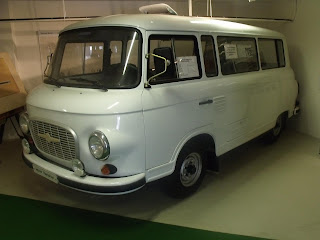This was a range of light commercial vehicles, namely vans and trucks of many derivatives.
They were made in East Germany, so part of the collective IFA, the body that governed all
East Germany auto production.
So, these commericals had much in common with the Trabant and especially the Wartburg,
which is evident in so many aspects of the design, trim and switchgear used.
You may recognise the door handles as being from the Wartburg and Trabant.
 |
| me in the Frankenberg Museum |
In some ways, the Barkas was very advanced for its time.
From 1961, it had front wheel drive, bigger loading capacity than most vans, and a unique
and very good suspension that featured semi-trailing arms. It was very unusual for its
time.
The Barkas was the only van manufactured in East Germany and came in a full range of
body styles.
 |
| fire service version |
 |
| Barkas 1100 prototype with Moskvitch 1500 engine. |
The factory for these was in Karl-marx-stadt, known nowadays as Chemnitz, with the
engines made in the Wartburg factory in Eisenach.
The new Barkas factory was built on the site of the old 'Framo' car factory, which was
seized by the Soviets and everything useful, machines, tool presses etc were boxed up
and sent to Russia as payment for War reparations, which was standard practice and
rampant throughout East Germany.
The 1000 signifies 1000kg payload, or one ton, which is the standard carrying capacity
for most average sized vans.
 |
| that almighty chassis! |
But, remarkably this vehicle was powered by a two stroke engine of 991cc, namely the same
engine that was used in the Wartburg car.
Unusually, the engine was in the cabin, positioned between the two front seats.
The engine was tuned to a lower power output (42hp) than the Wartburg car
but with a higher torque output for better pulling power.
This higher torque was largely created by the use of a cleverly designed exhaust
system that could extract torque in large quantities from the engine.
Top speed was a claimed sixty miles per hour, depending how heavily laden!
The vans were roomy and had a handy low loading height, from both the side and
rear doors.
Perhaps the most unique thing about the Barkas is it's fabulous suspension set up.
It's one piece body shell was mounted onto one hell of a sturdy chassis, which had
a huge outrigger bolted onto each side. These steel beams took the bulk of the
vehicle's weight off the body, whilst also adding stability. Simple, but also ingenious.
The strength and solidity of this chassis has to be seen to be believed.
The bodies of the Barkas were hand crafted by and utilised many small, gas spot welds
which must have been very labour intensive.
The B1000 had 12 volt electrics from the start. All previous commercials made by the
factory had 6 volts electrics.
 |
| Prisoner transporter, Hohenschonhausen Prison |
 |
| disguised on the outside to look like a delivery van |
The weak spot on the Barkas was its clutch. Again, shared by the Wartburg car, to which
it was perfectly suited, sadly for a commercial vehicle it was inadequate and would often
be replaced during the life of a vehicle.
A fully laden Barkas could weigh close to 2.5 tonnes, so expecting a car clutch to cope
with this kind of weight was a little optimistic.
Interestingly the factory made a prototype in 1972, the Barkas B1100 which used a
four stroke 1.5 engine of Moskvitch origin, based on the Moskvitch 412 car, but approval
to build it was never granted. The prototype produced 75hp, with a top speed of
120 km/h( 75mph). The design, whilst boxy was quite futuristic and modern for its time.
They had a six-wheeler version, made as a car transporter, which used a 1500cc
Lada engine, and did make it into production from 1978 onwards.
Main change came in 1989 and the Barkas got the 1.3 Volkswagen engine, shared with
the Wartburg 1.3. Barkas with this engine are signified by 1000/1.
There remains very few Barkas in existence today, at least good ones and
a restored one or one in excellent condition will fetch more than three thousand euros
these days. They are so unusual though, that I feel if you could get one, they'd make a
super investment as they'll soon be rarer than hens teeth, especially when you consider
what Volkswagen T2 vans are making currently. The two vans are comparable and
personally I'd much rather have the Barkas.
Main problem with their longevity was that old nemesis 'Rust' which gets many old cars
in the end. There must be hundreds of rusting Barkas hulks in barns and scrapyards
all over the former Gdr.
Just over 175,000 Two Stroke Barkas were made and almost 2000 four stroke models.











